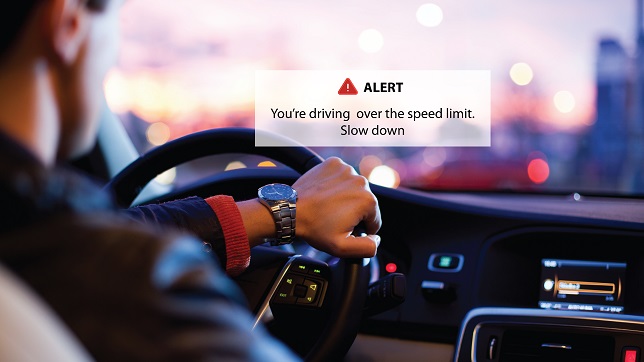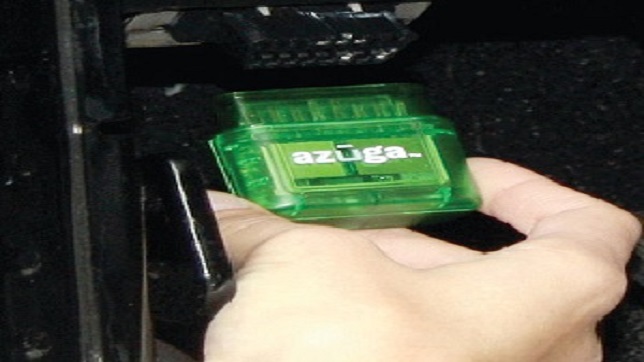Everything you need to know about Intelligent Speed Adaptation Systems

The actual cost of over-speeding
It is no news that the speed of your fleet influences the probability and severity of road accidents. The relationship between speed and severity of road crashes has been long recognized. In high-income countries, speed contributes to about 30% of deaths on the road while in some middle-income countries, the speed of the fleet at the time of the crash is quite pertinent to about half of all road fatalities. This relationship has proved critical for vulnerable road users like pedestrians and cyclists as well. Pedestrians have been shown to have a 90% chance of survival when struck by a car traveling at 30 km/h. However, the survival rates dip to 50% with a mere 15km/h increase in the car’s speed.
The fatality risk (%) vs. speed of a car (km/h) is plotted as seen in the graph above. One can easily trace the dramatic increase in pedestrian fatality with the slightest increase in the car’s speed. The above data throws light on how regulating speed limits can help reduce the contingency and impact of road crashes. Road crashes don’t just impose a threat to human lives but also adversely affect productivity and travel times. The cost of these road crashes averages 3% of the GNP (gross national product) for a majority of mid and high-income countries. This cost is nothing compared to the 1.2 million people who die and 50 million people who get injured every year because of road accidents all around the world. For businesses, a road accident means a hike in insurance premiums, thousands of bucks in legal fees, and expensive post-accidental repairs. Needless to say, a broken down fleet and an injured driver are not the only loss—the business also loses its precious money-making hours.
Intelligent Speed Adaptation (ISA)
Over-speeding and its adverse effects have created a need for sustainable speed-monitoring solutions. Several nations are looking up to the automotive telematics industry for help. By the end of next year, the European legislation requires carmakers to install GPS-enabled technologies that can warn drivers if they’re going above the speed limit on any road. They are popularly known as Intelligent Speed Adaptation systems and are a part of the intelligent transport system (ITS). Quickly reaching their technological maturity, they are here to reduce the incidence and trauma of road accidents. The intelligent speed adaptation systems are hence referred to as a class of ITS in which the driver is warned of over-speeding. Recent developments have also made it possible for ISA to interfere and restrict speeding when the driver is traveling over the limit.
There are two dominant classes of intelligent adaptation systems: speed alerting and speed limiting. With the speeding alerts, the system warns the drivers when they go over the speed limit. The warning can be visual as well as auditory. Whereas the speed-limiting systems give the drivers a “haptic” warning. In it, the driver will face increased upward pressure on the accelerator pedal. Thus, making it difficult for the driver to accelerate until the speed of the fleet returns within the complaint limits.
For both classes, the maximum speed at which travel can be permitted depends on the posted speed limits. For this to happen, information regarding the location and current speed of the vehicle is required. This is obtained primarily via global positioning systems or GPS technology. With its help, information regarding the road network, speed, and road infrastructure is stored in a digital database. An on-board computer continuously analyzes the location of the vehicle and compares the permissible speed limit with the current speed limit. Then, visual, auditory, or haptic warnings get issued.
Impact on Safety
For a very long time, ISAs were feared and seen as speed limiters. However, the true nature of intelligent speed adaptation systems is rather intricate and nuanced. In reality, the only intention of ISA systems is to enhance on-road safety. The society of automotive engineers cites that when ISA is used along with active safety features, the chances of a collision incident go down by 30%. The primary purpose of equipping cars with intelligent speed adaptation systems is to prevent speeding. These systems make sure that all fleet drivers oblige to speed limits. While advisory ISA systems are already available and deployed. However, fully intervening ISA systems are being tested and tried extensively. Trials conducted at the Norwegian Institute of Transport and Research show that the widespread adoption of ISAs will reduce pedestrian fatalities by 20%.
However, ISA systems do more than just reduce the occurrences of collisions. They increase driver alertness. It is very common for drivers to lose sight of the speed limits when traveling across long distances. With ISA, not only will the fleet be brought back to a complaint speed limit, but also the driver’s level of alertness will increase. Spiking up drivers’ attention can help prevent accidents that happen because of reckless overtaking or lane changing. Hence, these intelligent speed adaptation systems are designed to combat distracted or drowsy drivers as well. The complete realization of ISA systems is important to boost the safety and productivity of the fleet and its drivers. Once we do that, we’ll see how quickly we mitigate COAs( the cost of accidents). Any business that depends on logistics or transportation would greatly benefit from these ISA systems.
Studies and Trials
Several Asian and European countries like China, Malaysia, Netherlands, Denmark, the UK, and Finland are funding research and permitting trials of speed-alerting ISA systems. For instance, trials conducted by the University of Denmark involved twenty-four participants. These participants received a visual and auditory warning every time they exceeded the speed limits by 5km/h. The results of this trial were pretty astounding. Average speeds were lower when the participants drove with ISA systems. Additionally, 75% of participants held a positive response to the speed-monitoring device.
Similar results were seen in the trials conducted in Malaysia. 11 participants were required to drive vehicles that were fitted with ISA systems. The participants were asked how they felt about the speed monitoring system. In response, 9 out of 11 participants felt confident driving with a speed-limiting device. They said it helped them drive confidently—for they’ll always know when they exceed speed limits.
What’s Next for ISA systems?
It is understandable why businesses and the governments of the world would like to adhere to speed limits. Following speed limits means lesser human fatalities. It means a dramatic decrease in the socio-economic costs of accidents. This is why ISA systems should be mandated. Intelligent speed adaptation systems (ISA) are in-vehicle systems that compare the current speed of the vehicles with the permitted speed limit and send notifications accordingly. The intervening ISA systems, an advanced class of ISA, put upward pressure on the gas pedals—thus making it difficult for drivers to accelerate. The pressure is taken off once the fleet reaches a compliant speed limit. Studies and trials in multiple European countries have proved that ISA systems are effective in altering driver behavior. As an added advantage, these ISA systems are also successful in increasing driver alertness. As a consequence, driving behaviors, on the whole, were enhanced. Alert drivers seem to change lanes cautiously, stop at intersections, and don’t tailgate. Therefore, the complete realization of ISA systems is going to yield many benefits and their large-scale adoption is pertinent to on-road safety and efficient logistics.
References:
https://www.who.int/violence_injury_prevention/publications/road_traffic/world_report/speed_en.pdf
https://www.sciencedirect.com/science/article/pii/S0386111212000301
Author:

Tushar Bhagat
Director
Uffizio India Pvt. Ltd.
Tushar Bhagat is the CEO of Uffizio. He has simmered 15 years worth of informatics knowledge & experience into a one-of-a-kind telematics platform. This fleet management system has been acclaimed and widely used by businesses in over 60 countries. Mr. Bhagat firmly believes in finding creative solutions to everyday challenges—so businesses can bloom into their full potential.
Published in Telematics Wire


